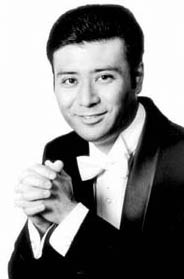home | metro silicon valley index | music & nightlife | band review

Photograph by Ellen Appel
It's Grieg to Him: Jon Nakamatsu provided the solo flourishes for the symphony's performance of Grieg's Piano Concerto in A Minor.
Standing Ovation
Pianist Jon Nakamatsu earned a grateful response from last Sunday's Symphony Silicon Valley audience
By Scott MacClelland
LOCAL HERO Jon Nakamatsu, winner of the 1997 Van Cliburn International Piano Competition, was welcomed back with cheers by a sell-out Symphony Silicon Valley audience Sunday just before his performance of Grieg's Piano Concerto in A Minor, that treasure of unforgettable "Nordic" themes. With guest conductor William Boughton on the podium, Nakamatsu brought a fresh lyrical touch to the old charmer. While his was not a bravura or even muscular performance, he did punch up the flourishes spinto-style. In slow passages. he caressed the music with thoughtful affection yet displayed a full range and mastery in the extended solos. At the performance's conclusion, Nakamatsu seemed taken aback by the explosive ovation that barreled across the footlights. Several curtain calls later, he answered the standing O with Schubert's Impromptu in E-flat, D. 899, in a flavorful recipe of his own inflection.
In the program handout, annotator Beth Fleming claimed that Sibelius' Fifth Symphony "was to become the composer's most popular." Not that it matters to those who admire all seven of the symphonies, but the Fifth lags far behind the Second in frequency of performance and recordings. Regardless, each of the symphonies has its unique characteristics, and an edgy urgency is a particular feature of the Fifth (which was composed during World War I).
The opening movement shares with the finale an anxiety-laden study in harmonic suspension; we always have a feeling of where we are going but not how or when we'll get there. A highlight of the final movement was the sotto voce passage on the strings, about a third of the way in, whose tremolos turned into a swarm of buzzing bees. The extravagant fanfares on brass with which the work draws to a close were thrilling in the room. Despite the work's formal and textural complexities, the orchestra acquitted itself handsomely. The audience response, however, suggested a lack of familiarity with the Fifth, the "most popular" claim notwithstanding. As an encore, Boughton led the players in the composer's little Valse triste.
Anyone acquainted with Luigi Cherubini's overture to the opera Anacreon knows where Beethoven's symphonic furies originated. There is probably no better example than his own Egmont overture. It was disappointing, then, when Boughton drew a tepid reading of a work well known to seethe with the kind of dramatic energy that is uniquely Beethoven. If the piece could be compared with a cat on the hunt, stalking, creeping and suddenly pouncing upon its prey, this kitty, for want of anything close to sufficient dynamic contrast and pace, never cornered anything more daunting than a tin of Fancy Feast.
However, it also revealed a thornier problem for those of us who recall the late San Jose Symphony. Fact is, Symphony Silicon Valley is a smaller orchestra, mainly due to fewer strings. Even in the acoustic efficiency of the California Theatre, its eight cellos struggle to deliver the full-bodied richness of the 10 cellos from those old days. And it can't help that concertmaster Robin Mayforth and principal violist Patricia Whaley have been sidelined for some while by injuries.
Send a letter to the editor about this story.
|
|
|
|
|
|